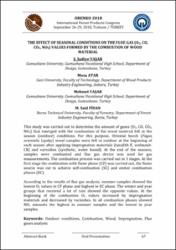THE EFFECT OF SEASONAL CONDITIONS ON THE FLUE GAS (O2, CO, CO2, NOX) VALUES FORMED BY THE COMBUSTION OF WOOD MATERIAL
Access
Attribution 3.0 United Statesinfo:eu-repo/semantics/openAccesshttp://creativecommons.org/licenses/by/3.0/us/Date
2018-09-26Access
Attribution 3.0 United Statesinfo:eu-repo/semantics/openAccesshttp://creativecommons.org/licenses/by/3.0/us/Metadata
Show full item recordAbstract
This study was carried out to determine the amount of gases (O2, CO, CO2, NOx) that emerged with the combustion of the wood material left in the season (outdoor) conditions. For this purpose, Oriental beech (Fagus orientalis Lipsky) wood samples were left in outdoor at the beginning of each season after applying impregnation materials (tanalith-E, wolmanit- CB) and varnishes (synthetic, water based). At the end of the seasons, samples were combusted and flue gas device was used for gas measurements. The combustion process was carried out in 3 stages. At the first stage the combustion with flame phase (CF) was carried out, the flame source was cut to achieve self-combustion (SC) and ember combustion phases (EC). According to the results of flue gas analysis, summer samples showed the lowest O2 values in CF phase and highest in EC phase. The winter and year groups that received a lot of rain showed the opposite values. At the beginning of the combustion O2 values increased by impregnation materials and decreased by varnishes. In all combustion phases showed NOx amounts the highest in summer samples and the lowest in year samples.
Collections
The following license files are associated with this item:



















